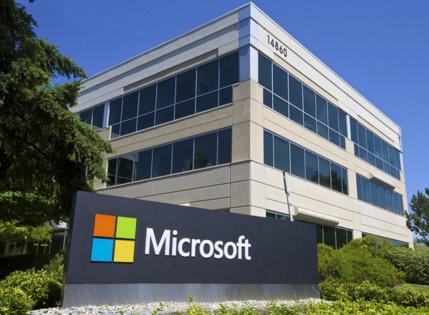Microsoft hasn't chased Amazon back to the office. It's even cutting back on office space
Published in Business News
The largest employer in Seattle's eastern suburbs won’t follow Amazon back to the office.
Last month, Amazon updated its return-to-office mandate by telling employees it expects them to work in person all five days of the workweek starting in January.
Its tech peer Microsoft took an opposite stance last week. Scott Guthrie, executive vice president of Microsoft’s cloud and AI division, told employees during an all-hands meeting that its remote work friendly policy wouldn’t change unless productivity wanes.
Guthrie didn’t give many specifics on how productivity among employees could falter, according to a report in Business Insider confirmed by The Seattle Times, and Microsoft’s recent performance shows a decline probably isn’t in the foreseeable future. The company reported a record $245 billion in revenue June for its fiscal 2024, with $88 billion in profit, according to regulatory filings.
Microsoft hasn’t had to deal with the strong reaction over in-person mandates that Amazon has, but as it continues to tweak the offices it’s running to address the quirks of hybrid work. And unlike Amazon, Microsoft has benefited from the rise of hybrid and remote work with products devoted to it like Teams.
Like other tech companies, Microsoft has shied away from strict policies since the pandemic.
“There is no one-size fits-all solution given the variety of roles, work requirements, and business needs we have at Microsoft,” a Microsoft spokesperson said in an emailed statement. “For most roles, we view working from home part of the time (less than 50%) as standard.”
At the end of last year, one of Microsoft’s cloud computing divisions based in Redmond, Washington, told its employees not to expect permanent desks and offices if they weren’t coming in at least 50% of the time.
In June, the same unit said employees designated to unassigned and communal desks and offices could earn back permanent spaces if their badge data showed them coming in at least three days a week, according to internal memos obtained by The Seattle Times.
Microsoft’s goal is to create fewer empty hallways and fill out floors with employees who come in regularly. One of the frequently asked questions in the memo was, if there are empty unassigned desks every day, why were employees asked to share offices, or “double,” if they wanted a permanent desk?
“This is a work in progress, we want to get close to full utilization, and not run short of touchdown space,” Microsoft managers said in the email. “For now, doubling is one of the options we have to bring more people into the building.”
In August, another internal memo for the unit suggested the strategy was working and office attendance had picked up as the team was filling out another floor.
But Microsoft is still making real estate moves that suggest it doesn’t expect to shift more than 53,000 Seattle-area employees back to the office full-time.
Some of its leased office space near the Redmond campus is offered as available next year, according to a listing from commercial brokerage Broderick Group. Out of the trio of buildings on the Redmond Woods office complex, Microsoft has space in all three but does not fully occupy any of them, according to city permit records. The listing shows it plans to dump a few floors in two of them.
Microsoft declined to comment on the Redmond Woods office.
For the past two years, Microsoft has been getting rid of offices on the Eastside as it opens new buildings at its Redmond headquarters, part of a $5 billion campus refresh announced in 2017.
At less than 50,000 square feet, the office space in Redmond Woods that the company looks to leave is much smaller than footprints it has already left in Bellevue, Redmond and Issaquah, Washington. Microsoft has vacated about 1.9 million square feet of office in downtown Bellevue, roughly 1 million square feet along Interstate 90 and almost 500,000 square feet in suburban Redmond.
It has also shelved plans for a four-building expansion of its RedWest campus in Redmond, according to city records. The plans, which were filed in 2021, would have added more than 1.1 million square feet for Microsoft. King County records show the company purchased the land from Nintendo of North America in 2007 for $42 million.
The office moves in Bellevue have had an effect on the workforce there. The city’s most recent annual report in July showed Microsoft employees had all but left, three years after it was Bellevue’s largest employer with about 9,300 workers based there.
Microsoft’s leases on the Eastside started expiring in 2022 and some run through 2025, dealing steady blows to the office market in downtown Bellevue and the I-90 corridor. The Eastside’s vacancy rate hit a low of 5.7% in 2019, but has risen to 20.2%, according to a recent report from the Broderick Group.
Even as companies like Amazon finish up new office towers in Bellevue and smaller firms look to occupy a few floors of prime space here and there, the departures from Microsoft keep causing supply to outpace demand each quarter.
Some of the floors vacated by Microsoft have already been snapped up. HDR Engineering and accounting firm Clark Nuber both recently picked up more than 90,000 square feet of space between them in Bellevue’s City Center Plaza. And TikTok has taken over most of the space in the Lincoln Square north tower that Microsoft left.
The Broderick Group report said vacancy rates in Seattle's eastern suburbs are expected to decline starting in 2026, but the market isn’t likely to favor landlords until 2027 unless a major tenant comes to the area and speeds up the process by six months to a year.
For Bellevue, Microsoft provided that type of recovery almost 20 years ago.
©2024 The Seattle Times. Visit seattletimes.com. Distributed by Tribune Content Agency, LLC.












Comments